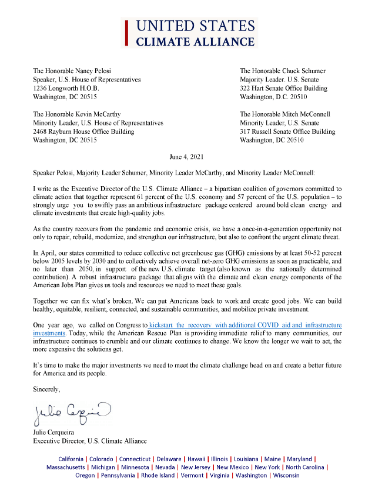Home / U.S. Climate Alliance Urges Congress to Pass Ambitious Infrastructure Package

As the country recovers from the pandemic and economic crisis, we have a once-in-a-generation opportunity not only to repair, rebuild, modernize, and strengthen our infrastructure, but also to confront the urgent climate threat.
In April, our states committed to reduce collective net greenhouse gas (GHG) emissions by at least 50-52 percent below 2005 levels by 2030 and to collectively achieve overall net-zero GHG emissions as soon as practicable, and no later than 2050, in support of the new U.S. climate target (also known as the nationally determined contribution). A robust infrastructure package that aligns with the climate and clean energy components of the American Jobs Plan gives us tools and resources we need to meet these goals.
Together we can fix what’s broken. We can put Americans back to work and create good jobs. We can build healthy, equitable, resilient, connected, and sustainable communities, and mobilize private investment.
One year ago, we called on Congress to kickstart the recovery with additional COVID aid and infrastructure investments. Today, while the American Rescue Plan is providing immediate relief to many communities, our infrastructure continues to crumble and our climate continues to change. We know the longer we wait to act, the more expensive the solutions get.
It’s time to make the major investments we need to meet the climate challenge head on and create a better future for America and its people.
Launched on June 1, 2017 by the governors of Washington, New York, and California to help fill the void left by the previous administration’s decision to withdraw the U.S. from the Paris Agreement, the Alliance has grown to include 24 governors from across the U.S. representing approximately 60% of the U.S. economy and 55% of the U.S. population. Governors in the Alliance have pledged to collectively reduce greenhouse gas emissions by at least 26-28% below 2005 levels by 2025, at least 50-52% below 2005 levels by 2030, and collectively achieve overall net-zero greenhouse gas emissions as soon as practicable, and no later than 2050.
The Alliance’s states and territories continue to demonstrate that climate action goes hand-in-hand with economic growth, job creation, and better public health. While reducing emissions by 18% between 2005 and 2021, Alliance members grew their collective GDP by nearly 30%. The coalition’s states and territories are employing more workers in the clean energy sector, achieving lower levels of dangerous air pollutants, and preparing more effectively for climate impacts and executing more pre-disaster planning than the rest of the country.
###